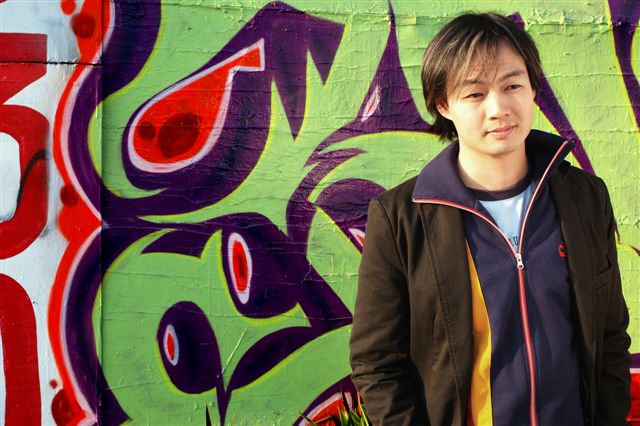Takeshi Murakami Pt. 1: Louis Vuitton
I’m blogging again because it’s 3:00 AM, and I can’t sleep. Mostly album related issues, but I’ll get to that later….
In the meantime, I’m going to ramble about Takeshi Murakami, probably the most famous pop artist since Andy Warhol. The LA MOCA (Museum of Contemporary Art) is running a show of the Tokyo-based artists works, and it’s driving me nuts that I don’t have the time to just run downtown to go see it.
 Murakami is the founder of the Superflat movement—which in essence is both a rebellion against the staid restraint of traditional Japanese art, as well as a celebration—and sometimes criticism—of contemporary Japanese pop culture. It’s a largely character-based movement—that is, much of the art deals with manga-inspired cartoon characters who require no more reason for existance than that they’re ridiculously cute.
Murakami is the founder of the Superflat movement—which in essence is both a rebellion against the staid restraint of traditional Japanese art, as well as a celebration—and sometimes criticism—of contemporary Japanese pop culture. It’s a largely character-based movement—that is, much of the art deals with manga-inspired cartoon characters who require no more reason for existance than that they’re ridiculously cute.
Like Warhol, his work is a marriage of fine art and commerce—and one of the most noticeable unions of these concepts is his design of a Louis Vuitton handbag (which sells for a mere $1520). Murakami goes one step further with the partnership, however, and actually created a little animated film to promote the product:
What I love about it in particular (being a musician) is the soundtrack, a song by a great J-Pop artist called Fantastic Plastic Machine. J-Pop is a particular interest of mine, just because I find it so much more creative than American pop (which for various reasons—cough Clear Channel cough American Idol cough hip-hop culture cough—has become image driven and homogenized). Some of my favorite artists (including previously-blogged-about Cornelius) all come from the trendy Shibuya district of Tokyo, and FPM belongs to this Shibuya-kei movement.
What’s particularly ingenious about this music, though, is that it seems to be a reinvention of a concept in German avant-garde concert music of the 1910s called klangfarbenmelodie, which translated, means ‘tone color melody.’ That technique, pioneered by Arnold Schoenberg and Anton Webern (who, along with Alban Berg, comprise the Second Viennese School) is the utilization of tone color as a new element to the progression of a melody. So for example, instead of having a melody played by just one instrument, these guys would break up the melody amongst different instruments in the orchestra, so that each note was sounded with a different tone color. Fantastic Plastic Machine has done this here as well—although the melody and chords would fit very handily with one instrument, the main riff is broken up into various combinations of acoustic guitar strums (going forwards and backwards), keyboards, pizzicato strings, filtered synths, and weird honking sounds. It’s mesmerizing, and works really well with the schizophrenic nature of Murakami’s visuals.
Oh, and guess what the name of the song is? “Different Colors.” How appropriate, both to Murakami AND klangfarbenmelodie.
And in other news, the reason I’ve got insomnia is because I spent much of today thinking over the comments that I’ve gotten from various people I played my most recent album draft for—and I’ve realized that there comes a time when an artist simply needs to stop collecting feedback, and just does what they want to do. And so even though there were some valid suggestions that came from my friends and colleagues in the past couple weeks, I’ve nevertheless reached a point where I’m comfortable with my material, and can confidently move forward with it. And truthfully, one could workshop something forever, and each time someone will have something new to say. It has to stop somewhere! More than anything else, this is telling in that I’ve finally reached a total comfort point with all my material. Next stop: Abbey Road.


1 Comments:
Nifty video. I thought the Murakami LV fairly less of a sell-out than most such art+fashion collaborations are – but I have seen a lot of them, and most are just embarrassments to both sides. The Murakami LV at least maintained a self-ironic whimsicality rare in these rather pompous industries.
It is something more than Japan’s comparative lack of industry monopolization (hip-hop and reality tv are everywhere now, and don’t get me even started on the creativity-killing nature of Chinese cultural industries!) that explains its warped/wacky cultural adventurous. I think as a result of and a reaction against the repressed rigidity of Japanese society, Japanese culture goes completely and wonderfully berserk. The foreign is taboo, so embrace the foreign! Quiet salaryman by day, charismatic cosplayer by night. And etc. You’d know better than I, but I believe the best comparison is Britain: only the prim, uptight Anglos could produce the "wha?!"-inducing oddballness of things like Monty Python and its many successors.
While I like Murakami, the whole "cartoon art" school is having a disastrous effect upon the sensibilities of the 1980s generation of artists in Greater China. A lot of garish, pointless, poorly executed stuff is showing now. Students eschew and circumvent the skills and sensibilities of both the fine arts and cartoons by haphazardly combining the two.
November 21, 2007 at 9:57 AM
Post a Comment
Subscribe to Post Comments [Atom]
<< Home